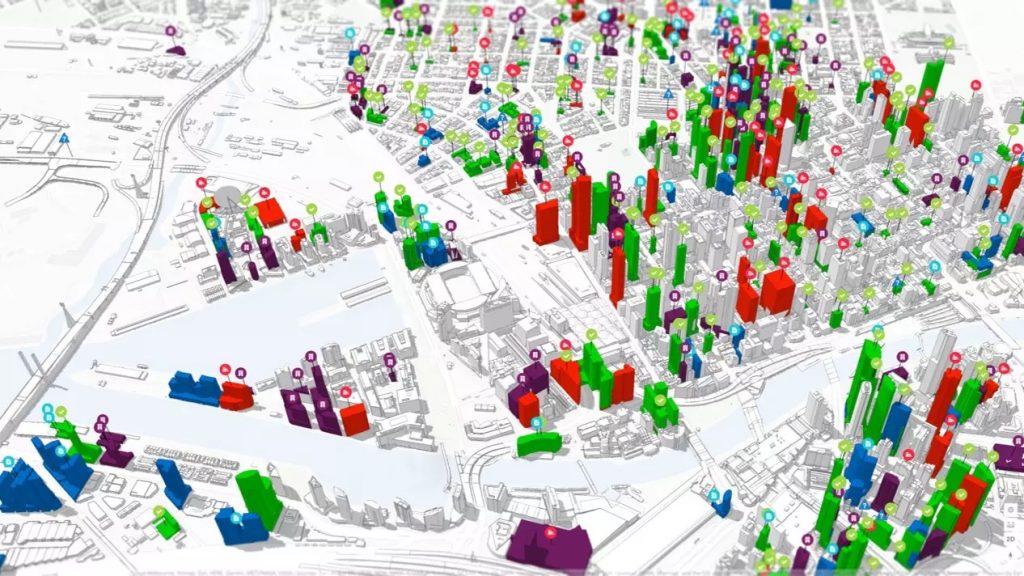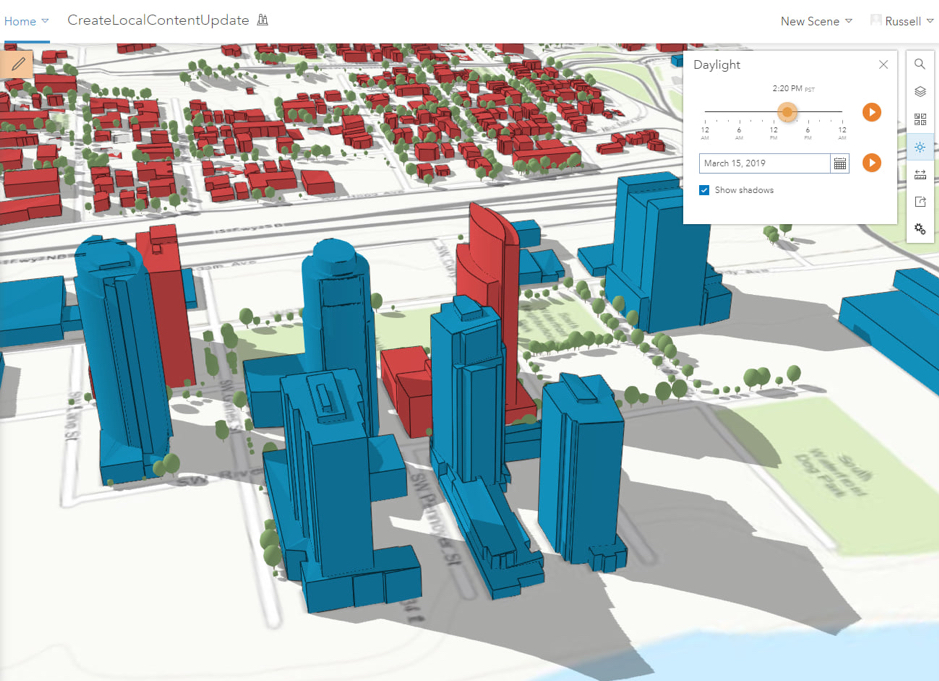Esri UK recently announced the winners of a competition to find local planning authorities with innovative ideas for how best to use geospatial technology to help digitise the planning process
Attracting almost 50 entries, the three winning councils were Nottingham, Dacorum Borough Council and South Ayrshire, who will work with Esri UK to make their pilot projects a reality, receiving free consultancy and access to GIS (Geographic Information Systems) software from the company.
Use of GIS to digitise the planning process
The competition revealed several common planning challenges faced by local authorities being addressed by the pilots, including the improvement of community engagement, how to maximise the use of 3D visualisations and how to manage developer contributions more efficiently. Esri UK is also creating a Customer Advisory Board to help grow best practice use of GIS within planning.
“As the government looks to reform the planning system with an increased use of digital technologies, we wanted to find innovative solutions to planning challenges and collaborate with authorities to bring them to life,” said Stephen Croney, head of sector for land, property and planning at Esri UK.
“By combining each council’s domain expertise with our team of geospatial experts, the pilot projects will explore new and efficient approaches to problems all designed to help make the planning process easier for everyone.”
Nottingham City Council’s project will examine how geospatial technology can help increase the use of 3D visualisations within planning, both internally and with the public. Dacorum Borough Council’s pilot will be using GIS systems to better manage the use and communication of developer contributions secured through planning obligations, while South Ayrshire Council’s objective is to create an innovative community consultation platform with interactive methods of engagement to improve community involvement in Local Development Plans.
“Geospatial technologies can help shape the future of the planning process by delivering significant cost and time savings,” said Croney.
“Spatial data provides the common language to join different data together and make it meaningful. Helping to understand the spatial nature of our environment so that we can better determine its future means that more sustainable communities are created and helps with the Levelling Up agenda too.”
The Customer Advisory Board will provide a forum for local planning authorities to discuss best practice and share common problems and goals.
“It became clear that finding new ways of applying GIS in planning opened the minds of councils entering the competition as to what problems could be solved,” Croney said.
“The advisory board will help planning teams learn from each other, make better use of their investment in GIS and shape the future of digital transformation within planning.”

Geospatial technology can help digitise the planning process
Geospatial technology and data play an important role in helping to digitise the planning process, as outlined in the Planning for the Future white paper, published by the Ministry of Housing, Communities & Local Government in 2020. The use of mapping and associated analytical tools was also one of the recommendations in the report A Digital Future for Planning: Spatial Planning Reimagined, released in February by the independent Digital Task Force for Planning.
Selected from almost 50 entries, the winning applications are:
Dacorum Borough Council
Dacorum Borough Council wants to translate existing text and spreadsheets by using digital mapping to better manage and communicate infrastructure and developer contributions, secured through planning obligations.
“The objective is to use digital mapping to help with not only the decision making around the planning of new infrastructure and make the whole process more transparent but also to support community engagement,” said Councillor Alan Anderson, portfolio holder, planning and infrastructure at Dacorum Borough Council.
“Our current system outputs are text- and spreadsheet-based – we believe that by providing this information in a spatial way, it will provide a powerful asset which can be used by council officers and others for planning, decision making and monitoring, and also by the public to enhance understanding and engagement in infrastructure funding and planning. The pilot will deliver cost and time savings through the delivery of more automated processes, while also freeing up officer resource/capacity to deal with other complex issues.”
A lack of understanding of infrastructure requirements, including costs and timescales for delivery, is frequently a reason for Local Plans failing at independent examination, resulting in authorities starting a new plan afresh. Understanding infrastructure is a big issue for Local Plans at examination. National policy and guidance have set the bar higher now than ever before with respect to the level of evidence and knowledge required.
Nottingham City Council
Nottingham City Council’s proposition will explore how geospatial technology can help increase the use of 3D visualisations within the planning environment, internally and with the public.
Like many councils, the team already has a 3D model assessment built into its process, whereby developer models are inserted into 3D software for a visual assessment. The pilot project’s objective is to look at how this can be done within a GIS environment, which would add the benefit of being able to conduct a holistic assessment of other available data, including Local Plan information such as flood risk, allocation sites, listed buildings etc, in the same place.
“If assessments are conducted in a GIS environment, planning teams will be able to conduct an assessment of various constraints on a site, at the same time as a visual assessment of the impact of the site. This will enable better and quicker business decisions and greatly contribute to modernising the planning processes as per the government white paper,” explained Mick Dunn, GIS service manager, Nottingham City Council.
“GIS will bring other capabilities to the process too, from in-depth flooding analysis to view analysis, which we would like to be able to share easily with interested parties, from images of views and flythroughs to an online version of the model. We feel this could be pushed even further, perhaps being able to provide VR (virtual reality) consultation on sites.
“For example, a QR code on a planning notification near the proposed site, which links to a VR experience on your mobile phone. Assessments need to be enhanced using new techniques such as this, as public expectations rise, in line with improvements in technology.”
South Ayrshire Council
South Ayrshire Council’s project will examine how an innovative community consultation platform with interactive methods of engagement can help further improve community involvement in Local Development Plans – the proposed South Ayrshire LDP2 in the first instance.
The collaboration will involve new mapping and analytical techniques to engage more widely with stakeholders, about their vision for how communities will grow and develop in the future within South Ayrshire.
“The objective is to create a space to keep our community engaged and informed to strengthen our relationship with our stakeholders in order to reach better planning outcomes,” said Gordon Wilson, planning technician at South Ayrshire Council.
“Effective public engagement can lead to better plans, better decisions and more satisfactory outcomes, and it can help to avoid delays in the planning process too. Our vision is to build on the work already done by South Ayrshire in creating its LDP2, developing new apps and information to create a Local Plan community engagement and consultation hub, which will be more accessible, as the majority of people are now online.
“Digital engagement will reach more people and will present the opportunity to hear diverse voices. Reaching more people leads to higher participation and having more data creates more knowledge. A huge benefit will be that the community can participate anytime, anywhere.”
Stephen Croney

Head of sector for land, property and planning
Esri UK
Tel: +44 (0)1296 745 555
Twitter: @esriuk
LinkedIn: esriuk
Facebook: EsriUK










![[VIDEO] Making DorTrak reports easy to read with Fireco Inspecting fire doors at Fireco, firedoor technology, 2023](https://www.pbctoday.co.uk/news/wp-content/uploads/2024/04/JPZ_2364-web-218x150.jpg)
![[VIDEO] Re-flow Field Management review by Traffic Management Installations When TMI began subcontracting for councils and government bodies, they wanted to present their site reporting in a more professional manner](https://www.pbctoday.co.uk/news/wp-content/uploads/2025/03/TMI-Media-1-218x150.png)


